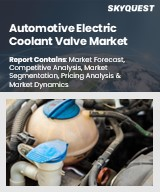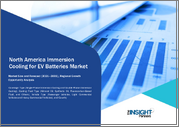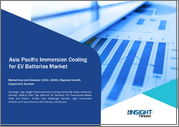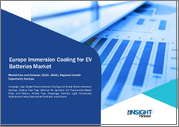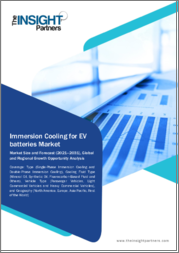
|
시장보고서
상품코드
1569814
세계의 배터리 냉각 플레이트 시장 예측(-2030년) : 냉각 방법별, 재료 유형별, 배터리 유형별, 차종별, 용도별, 지역별 분석Battery Cooling Plate Market Forecasts to 2030 - Global Analysis By Cooling Method (Air Cooling, Liquid Cooling, Phase Change Material Cooling and Immersion Cooling), Material Type, Battery Type, Vehicle Type, Application and By Geography |
||||||
Stratistics MRC에 따르면 배터리 냉각판 세계 시장은 2024년에 7억 3,270만 달러를 차지하고, 예측 기간 동안 CAGR은 36.2%로 성장하고, 2030년에는 46억 7,750만 달러에 이를 전망입니다.
배터리 냉각 플레이트는 특히 전기자동차 및 에너지 저장 용도의 리튬 이온 배터리의 열 관리 시스템에서 중요한 구성 요소입니다. 일반적으로 알루미늄이나 구리와 같은 전도성이 높은 재료로 만들어진 얇고 평평한 장치로 배터리 셀에서 효율적으로 열을 제거하도록 설계되었습니다. 플레이트에는 냉각수 순환을 위한 내부 채널과 통로가 있어 충방전 중 배터리 온도를 최적으로 유지합니다. 온도 균일성을 조정하고 과열을 방지함으로써 냉각 플레이트는 배터리 성능을 향상시키고, 수명을 연장하고, 안전성을 향상시키고, 고성능 배터리 시스템의 고속 충전 기능을 가능하게 합니다.
EV 대수에 따르면 배터리 전기자동차(BEV) 판매량은 2022년 전년 대비 59% 증가한 약 800만대에 달했습니다. 플러그인 하이브리드 자동차(PHEV) 판매량은 46% 증가한 약 260만대에 달했습니다.
전기차 수요 증가
전기자동차(EV)의 보급 확대는 배터리 냉각 플레이트 시장의 주요 촉진요인입니다. EV의 생산과 판매가 세계적으로 급증함에 따라 효율적인 배터리 열 관리 시스템에 대한 수요가 증가하고 있습니다. 배터리 냉각 플레이트는 EV 배터리의 최적 작동 온도를 유지하고 성능, 수명 및 안전성을 높이는 데 중요한 역할을 합니다. EV의 항속 거리 연장과 고속 충전 기능의 추진은 고급 냉각 솔루션의 필요성을 더욱 강조하고 있습니다. 이 추세는 앞으로도 계속될 것으로 예상되며 배터리 냉각판 시장의 상당한 성장을 이끌어 갈 것입니다.
높은 초기 비용
고급 냉각 플레이트, 특히 액체 냉각 기술을 이용한 냉각 플레이트의 개발 및 제조에는 연구, 재료 및 제조 공정에 많은 투자가 필요합니다. 이러한 비용은 최종 사용자에게 전가되는 경우가 많고, 특히 가격에 민감한 시장이나 소규모 전기자동차 제조업체에게는 채용이 제한될 가능성이 있습니다. 과제는 성능 향상과 비용 효율성의 균형을 맞추어 다양한 차량 부문 및 시장에서 배터리 냉각 플레이트를 더 쉽게 사용할 수 있도록 하는 것입니다.
산업화와 도시화의 진전
도시가 확대되고 산업 활동이 활발해짐에 따라 전기자동차, 에너지 저장 시스템 및 효율적인 배터리 관리가 필요한 기타 용도에 대한 수요가 증가하고 있습니다. 이러한 도시화로 인해 지속가능한 운송 솔루션에 대한 필요성이 증가하고 있으며 배터리 냉각판이 중요한 역할을 하고 있습니다. 게다가 신재생에너지 시스템과 송전망의 안정화에 있어서의 대형 배터리의 산업용도는 냉각 플레이트 기술에 새로운 길을 열어 자동차 용도 이외에도 시장을 확대하고 있습니다.
경제 상황 변동
경기침체는 전기자동차에 대한 소비자 지출의 감소와 신재생에너지 프로젝트에 대한 투자의 감소로 이어질 수 있습니다. 원료 가격 변동, 특히 고성능 냉각 플레이트에 사용되는 특수 재료는 제조 비용과 이익률에 영향을 줄 수 있습니다. 경제의 불확실성은 또한 R&D 노력을 둔화시키고 냉각 플레이트 기술의 혁신을 방해할 수 있습니다.
COVID-19의 영향:
COVID-19의 대유행으로 인해 처음에는 공급망의 중단과 제조 정체로 인해 배터리 냉각판 시장이 혼란스러웠습니다. 그러나 이 위기는 또한 전기자동차와 재생 가능 에너지로의 이동을 가속화하고 배터리 냉각 플레이트의 장기 수요를 밀어 올렸습니다. 유행은 공급망의 탄력성과 현지 생산의 중요성을 부각시켜 시장 전망을 재구성할 수 있습니다. 유행 후 그린 테크놀러지에 초점을 맞춘 부흥 노력은 시장 성장을 더욱 촉진할 것으로 예상됩니다.
예측기간 동안 액체냉각분야가 최대화될 전망
액체 냉각 분야는 예측 기간 동안 최대 시장 점유율을 차지할 것으로 예측됩니다. 액체 냉각 시스템은 공기 냉각에 비해 우수한 열 관리 능력을 갖추고 있으며, 고성능 전기자동차 및 에너지 저장 용도에 이상적입니다. 이 기술은 보다 효율적인 방열을 가능하게 하고, 충전 속도의 고속화와 배터리 수명의 향상을 실현합니다. 대형 배터리 팩과 고출력 전기자동차가 보급됨에 따라 액체 냉각 플레이트 수요가 급증할 것으로 예상됩니다. 이 부문의 성장은 냉각수의 제형과 플레이트의 설계가 발전하고 전체 시스템의 효율성을 향상시킴으로써 더욱 촉진됩니다.
상용차 부문은 예측기간 중 가장 높은 CAGR이 예상된다.
상용차 부문은 예측 기간 동안 CAGR이 가장 높을 것으로 예측됩니다. 이 급성장은 배달 밴, 버스, 트럭과 같은 상용차의 전동화가 진행되고 있기 때문입니다. 상용 전기자동차는 사용률이 높고 부하가 많고 급속 충전 기능이 요구되므로 보다 견고한 배터리 냉각 솔루션이 필요합니다. 기업과 지자체가 지속가능성 목표를 달성하고 운영비용을 줄이기 위해 전기상용차를 채용하는 경우가 늘어나고 있기 때문에 이 부문에서는 고급 배터리 냉각판에 대한 수요가 가속될 것으로 보입니다.
최대 공유 지역:
예측 기간 동안 아시아태평양이 가장 큰 시장 점유율을 차지할 것으로 예상됩니다. 이 우위는 주로, 특히 중국, 일본, 한국 등의 나라에서 전기자동차의 생산과 도입에 있어서 이 지역이 주도권을 잡고 있기 때문입니다. 이 지역에는 주요 배터리 제조업체와 자동차 OEM이 있기 때문에 배터리 냉각 플레이트 수요가 크게 증가하고 있습니다. 또한 전기자동차의 보급을 촉진하는 정부의 이니셔티브와 충전 인프라에 대한 투자가 시장 성장을 더욱 뒷받침하고 있습니다. 이 지역의 배터리 부품 및 냉각 기술에 대한 견고한 공급망도 시장의 견인 역할을 하고 있습니다.
CAGR이 가장 높은 지역:
아시아태평양은 예측 기간 동안 유리한 성장률을 보일 것으로 예측됩니다. 이 급성장은 이 지역의 국가들이 설정한 적극적인 전기차 도입 목표에 더해 배터리 기술과 제조 능력에 대한 많은 투자가 뒷받침되고 있습니다. 인도 및 동남아시아 국가 등 국내 EV 시장의 확대는 배터리 냉각판 제조업체에 새로운 비즈니스 기회를 가져올 것으로 기대됩니다. 또한 차세대 배터리 기술 및 열 관리 솔루션 개발에 주력하는 이 지역은 냉각 플레이트 설계의 혁신을 촉진하고 아시아태평양 시장 성장을 더욱 가속화할 가능성이 높습니다.
무료 주문을 받아서 만드는 서비스:
이 보고서를 구독하는 고객은 다음 무료 맞춤설정 옵션 중 하나를 사용할 수 있습니다.
- 기업 프로파일
- 추가 시장 기업의 종합적 프로파일링(3개사까지)
- 주요 기업의 SWOT 분석(3개사까지)
- 지역 세분화
- 고객의 관심에 응한 주요국 시장 추계·예측·CAGR(주: 타당성 확인에 따름)
- 경쟁 벤치마킹
- 제품 포트폴리오, 지리적 존재, 전략적 제휴에 기반한 주요 기업 벤치마킹
목차
제1장 주요 요약
제2장 서문
- 개요
- 이해관계자
- 조사 범위
- 조사 방법
- 데이터 마이닝
- 데이터 분석
- 데이터 검증
- 조사 접근
- 조사 정보원
- 1차 조사 정보원
- 2차 조사 정보원
- 전제조건
제3장 시장 동향 분석
- 성장 촉진요인
- 억제요인
- 기회
- 위협
- 용도 분석
- 신흥 시장
- COVID-19의 영향
제4장 Porter's Five Forces 분석
- 공급기업의 협상력
- 구매자의 협상력
- 대체품의 위협
- 신규 참가업체의 위협
- 경쟁 기업간 경쟁 관계
제5장 세계의 배터리 냉각 플레이트 시장 : 냉각 방법별
- 공냉
- 액체 냉각
- 직접 액체 냉각
- 간접 액체 냉각
- 히트 파이프
- 콜드 플레이트
- 기타
- 상변화 물질(PCM) 냉각
- 침지 냉각
제6장 세계의 배터리 냉각 플레이트 시장 : 재료 유형별
- 알루미늄
- 구리
- 흑연
- 복합재료
- 기타
제7장 세계의 배터리 냉각 플레이트 시장 : 배터리 유형별
- 리튬 이온 배터리
- 고체 배터리
- 납축전지
- 니켈 수소 전지
- 기타
제8장 세계의 배터리 냉각 플레이트 시장 : 차종별
- 승용차
- 상용차
- 소형 상용차
- 대형 상용차
제9장 세계의 배터리 냉각 플레이트 시장 : 용도별
- 전기자동차(EV)
- 배터리 전기자동차(BEV)
- 플러그인 하이브리드 전기자동차(PHEV)
- 하이브리드 전기자동차(HEV)
- 에너지 저장 시스템(ESS)
- 휴대용 전자 기기
- 산업용도
- 항공우주 및 방어
- 선박
- 기타
제10장 세계의 배터리 냉각 플레이트 시장 :지역별
- 북미
- 미국
- 캐나다
- 멕시코
- 유럽
- 독일
- 영국
- 이탈리아
- 프랑스
- 스페인
- 기타 유럽
- 아시아태평양
- 일본
- 중국
- 인도
- 호주
- 뉴질랜드
- 한국
- 기타 아시아태평양
- 남미
- 아르헨티나
- 브라질
- 칠레
- 기타 남미
- 중동 및 아프리카
- 사우디아라비아
- 아랍에미리트(UAE)
- 카타르
- 남아프리카
- 기타 중동 및 아프리카
제11장 주요 발전
- 계약/파트너십/협업/합작투자(JV)
- 인수와 합병
- 신제품 발매
- 사업 확대
- 기타 주요 전략
제12장 기업 프로파일링
- BorgWarner Inc.
- Sogefi Group
- Dana Limited
- MAHLE GmbH
- Modine Manufacturing Company
- Nippon Light Metals
- Priatherm
- SANHUA Automotive
- Bespoke Composite Panels
- Estra Automotive
- HELLA GmbH & Co. KGaA
- KOHSAN Co., Ltd.
- Nisshinbo Holdings Inc.
- LG Chem
- Panasonic Corporation
- Samsung SDI
- CATL
- BYD
According to Stratistics MRC, the Global Battery Cooling Plate Market is accounted for $732.7 million in 2024 and is expected to reach $4677.5 million by 2030 growing at a CAGR of 36.2% during the forecast period. A battery cooling plate is a critical component in thermal management systems for lithium-ion batteries, particularly in electric vehicles and energy storage applications. It's a thin, flat device typically made of highly conductive materials like aluminum or copper, designed to efficiently remove heat from battery cells. The plate contains internal channels or passages for coolant circulation, maintaining optimal battery temperature during charging and discharging. By regulating temperature uniformity and preventing overheating, cooling plates enhance battery performance, extend lifespan, improve safety, and enable faster charging capabilities in high-performance battery systems.
According to EV volumes, battery electric vehicle (BEV) sales grew by 59% year-over-year in 2022, reaching approximately 8 million units. Plug-in hybrid electric vehicle (PHEV) sales grew by 46% to reach around 2.6 million units.
Market Dynamics:
Driver:
Increasing demand for electric vehicles
The growing adoption of electric vehicles (EVs) is a primary driver for the battery cooling plate market. As EV production and sales surge globally, the demand for efficient battery thermal management systems increases. Battery cooling plates play a crucial role in maintaining optimal operating temperatures for EV batteries, enhancing their performance, longevity, and safety. The push for longer driving ranges and faster charging capabilities in EVs further emphasizes the need for advanced cooling solutions. This trend is expected to continue, driving substantial growth in the battery cooling plate market.
Restraint:
High initial costs
Developing and manufacturing sophisticated cooling plates, especially those using liquid cooling technology, requires substantial investment in research, materials, and production processes. These costs are often passed on to end-users, potentially limiting adoption, particularly in price-sensitive markets or for smaller electric vehicle manufacturers. The challenge lies in balancing performance improvements with cost-effectiveness to make battery cooling plates more accessible across various vehicle segments and markets.
Opportunity:
Growing industrialization and urbanization
As cities expand and industrial activities increase, there's a growing demand for electric vehicles, energy storage systems, and other applications requiring efficient battery management. This urbanization drives the need for sustainable transportation solutions, where battery cooling plates play a crucial role. Additionally, industrial applications of large-scale batteries in renewable energy systems and grid stabilization create new avenues for cooling plate technologies, expanding the market beyond automotive applications.
Threat:
Fluctuations in economic conditions
Economic downturns can lead to reduced consumer spending on electric vehicles and decreased investments in renewable energy projects. Fluctuations in raw material prices, particularly for specialized materials used in high-performance cooling plates, can impact manufacturing costs and profit margins. Economic uncertainties may also slow down research and development efforts, potentially hindering innovation in cooling plate technologies.
Covid-19 Impact:
The COVID-19 pandemic initially disrupted the battery cooling plate market due to supply chain interruptions and manufacturing slowdowns. However, the crisis also accelerated the shift towards electric vehicles and renewable energy, boosting long-term demand for battery cooling plates. The pandemic highlighted the importance of supply chain resilience and localized production, potentially reshaping the market landscape. Post-pandemic recovery efforts focusing on green technologies are expected to further drive market growth.
The liquid cooling segment is expected to be the largest during the forecast period
The liquid cooling segment is projected to account for the largest market share during the projection period. Liquid cooling systems offer superior thermal management capabilities compared to air cooling, making them ideal for high-performance electric vehicles and energy storage applications. This technology allows for more efficient heat dissipation, enabling faster charging rates and improved battery longevity. As electric vehicles with larger battery packs and higher power outputs become more prevalent, the demand for liquid cooling plates is expected to surge. The segment's growth is further driven by advancements in coolant formulations and plate designs, enhancing overall system efficiency.
The commercial vehicles segment is expected to have the highest CAGR during the forecast period
The commercial vehicles segment is projected to have the highest CAGR during the extrapolated period. This rapid growth is attributed to the increasing electrification of commercial fleets, including delivery vans, buses, and trucks. Commercial electric vehicles often require more robust battery cooling solutions due to their higher utilization rates, heavier loads, and demand for fast charging capabilities. As businesses and municipalities increasingly adopt electric commercial vehicles to meet sustainability goals and reduce operating costs, the demand for advanced battery cooling plates in this segment is set to accelerate.
Region with largest share:
During the projected timeframe, the Asia Pacific region is expected to hold the largest market share. This dominance is primarily due to the region's leadership in electric vehicle production and adoption, particularly in countries like China, Japan, and South Korea. The presence of major battery manufacturers and automotive OEMs in the region drives significant demand for battery cooling plates. Additionally, government initiatives promoting electric vehicle adoption and investments in charging infrastructure further boost market growth. The region's robust supply chain for battery components and cooling technologies also contributes to its market leadership.
Region with highest CAGR:
The Asia Pacific region is predicted to witness the lucrative growth rate throughout the forecast period. This rapid growth is fueled by aggressive electric vehicle adoption targets set by countries in the region, coupled with substantial investments in battery technology and manufacturing capabilities. The expansion of domestic EV markets in countries like India and Southeast Asian nations is expected to create new opportunities for battery cooling plate manufacturers. Furthermore, the region's focus on developing next-generation battery technologies and thermal management solutions is likely to drive innovation in cooling plate design, further accelerating market growth in Asia Pacific.
Key players in the market
Some of the key players in Battery Cooling Plate Market include BorgWarner Inc., Sogefi Group, Dana Limited, MAHLE GmbH, Modine Manufacturing Company, Nippon Light Metals, Priatherm, SANHUA Automotive, Bespoke Composite Panels, Estra Automotive, HELLA GmbH & Co. KGaA, KOHSAN Co., Ltd., Nisshinbo Holdings Inc., LG Chem, Panasonic Corporation, Samsung SDI, CATL, and BYD.
Key Developments:
In August 2024, Modine, a diversified global company recognized for its thermal management technology and solutions, recently announced the release of its new EVsantage electric compressor and valve product lines, specifically designed to meet the demanding operational needs of heavy-duty electric vehicles.
In February 2023, BorgWarner announced it will supply a major German vehicle manufacturer in Europe and the U.S. with innovative battery cooling plates for their next-generation electric vehicles. The plates are designed to provide cooling capacity in a more compact package with reduced weight and cost.
Cooling Methods Covered:
- Air Cooling
- Liquid Cooling
- Phase Change Material (PCM) Cooling
- Immersion Cooling
Material Types Covered:
- Aluminum
- Copper
- Graphite
- Composite Materials
- Other Material Types
Battery Types Covered:
- Lithium-Ion Batteries
- Solid-State Batteries
- Lead-Acid Batteries
- Nickel-Metal Hydride Batteries
- Other Battery Types
Vehicle Types Covered:
- Passenger Vehicles
- Commercial Vehicles
Applications Covered:
- Electric Vehicles (EVs)
- Energy Storage Systems (ESS)
- Portable Electronics
- Industrial Applications
- Aerospace and Defense
- Marine
- Other Applications
Regions Covered:
- North America
- US
- Canada
- Mexico
- Europe
- Germany
- UK
- Italy
- France
- Spain
- Rest of Europe
- Asia Pacific
- Japan
- China
- India
- Australia
- New Zealand
- South Korea
- Rest of Asia Pacific
- South America
- Argentina
- Brazil
- Chile
- Rest of South America
- Middle East & Africa
- Saudi Arabia
- UAE
- Qatar
- South Africa
- Rest of Middle East & Africa
What our report offers:
- Market share assessments for the regional and country-level segments
- Strategic recommendations for the new entrants
- Covers Market data for the years 2022, 2023, 2024, 2026, and 2030
- Market Trends (Drivers, Constraints, Opportunities, Threats, Challenges, Investment Opportunities, and recommendations)
- Strategic recommendations in key business segments based on the market estimations
- Competitive landscaping mapping the key common trends
- Company profiling with detailed strategies, financials, and recent developments
- Supply chain trends mapping the latest technological advancements
Free Customization Offerings:
All the customers of this report will be entitled to receive one of the following free customization options:
- Company Profiling
- Comprehensive profiling of additional market players (up to 3)
- SWOT Analysis of key players (up to 3)
- Regional Segmentation
- Market estimations, Forecasts and CAGR of any prominent country as per the client's interest (Note: Depends on feasibility check)
- Competitive Benchmarking
- Benchmarking of key players based on product portfolio, geographical presence, and strategic alliances
Table of Contents
1 Executive Summary
2 Preface
- 2.1 Abstract
- 2.2 Stake Holders
- 2.3 Research Scope
- 2.4 Research Methodology
- 2.4.1 Data Mining
- 2.4.2 Data Analysis
- 2.4.3 Data Validation
- 2.4.4 Research Approach
- 2.5 Research Sources
- 2.5.1 Primary Research Sources
- 2.5.2 Secondary Research Sources
- 2.5.3 Assumptions
3 Market Trend Analysis
- 3.1 Introduction
- 3.2 Drivers
- 3.3 Restraints
- 3.4 Opportunities
- 3.5 Threats
- 3.6 Application Analysis
- 3.7 Emerging Markets
- 3.8 Impact of Covid-19
4 Porters Five Force Analysis
- 4.1 Bargaining power of suppliers
- 4.2 Bargaining power of buyers
- 4.3 Threat of substitutes
- 4.4 Threat of new entrants
- 4.5 Competitive rivalry
5 Global Battery Cooling Plate Market, By Cooling Method
- 5.1 Introduction
- 5.2 Air Cooling
- 5.3 Liquid Cooling
- 5.3.1 Direct Liquid Cooling
- 5.3.2 Indirect Liquid Cooling
- 5.3.2.1 Heat Pipes
- 5.3.2.2 Cold Plates
- 5.3.2.3 Other Techniques
- 5.4 Phase Change Material (PCM) Cooling
- 5.5 Immersion Cooling
6 Global Battery Cooling Plate Market, By Material Type
- 6.1 Introduction
- 6.2 Aluminum
- 6.3 Copper
- 6.4 Graphite
- 6.5 Composite Materials
- 6.6 Other Material Types
7 Global Battery Cooling Plate Market, By Battery Type
- 7.1 Introduction
- 7.2 Lithium-Ion Batteries
- 7.3 Solid-State Batteries
- 7.4 Lead-Acid Batteries
- 7.5 Nickel-Metal Hydride Batteries
- 7.6 Other Battery Types
8 Global Battery Cooling Plate Market, By Vehicle Type
- 8.1 Introduction
- 8.2 Passenger Vehicles
- 8.3 Commercial Vehicles
- 8.3.1 Light Commercial Vehicles
- 8.3.2 Heavy Commercial Vehicles
9 Global Battery Cooling Plate Market, By Application
- 9.1 Introduction
- 9.2 Electric Vehicles (EVs)
- 9.2.1 Battery Electric Vehicles (BEVs)
- 9.2.2 Plug-in Hybrid Electric Vehicles (PHEVs)
- 9.2.3 Hybrid Electric Vehicles (HEVs)
- 9.3 Energy Storage Systems (ESS)
- 9.4 Portable Electronics
- 9.5 Industrial Applications
- 9.6 Aerospace and Defense
- 9.7 Marine
- 9.8 Other Applications
10 Global Battery Cooling Plate Market, By Geography
- 10.1 Introduction
- 10.2 North America
- 10.2.1 US
- 10.2.2 Canada
- 10.2.3 Mexico
- 10.3 Europe
- 10.3.1 Germany
- 10.3.2 UK
- 10.3.3 Italy
- 10.3.4 France
- 10.3.5 Spain
- 10.3.6 Rest of Europe
- 10.4 Asia Pacific
- 10.4.1 Japan
- 10.4.2 China
- 10.4.3 India
- 10.4.4 Australia
- 10.4.5 New Zealand
- 10.4.6 South Korea
- 10.4.7 Rest of Asia Pacific
- 10.5 South America
- 10.5.1 Argentina
- 10.5.2 Brazil
- 10.5.3 Chile
- 10.5.4 Rest of South America
- 10.6 Middle East & Africa
- 10.6.1 Saudi Arabia
- 10.6.2 UAE
- 10.6.3 Qatar
- 10.6.4 South Africa
- 10.6.5 Rest of Middle East & Africa
11 Key Developments
- 11.1 Agreements, Partnerships, Collaborations and Joint Ventures
- 11.2 Acquisitions & Mergers
- 11.3 New Product Launch
- 11.4 Expansions
- 11.5 Other Key Strategies
12 Company Profiling
- 12.1 BorgWarner Inc.
- 12.2 Sogefi Group
- 12.3 Dana Limited
- 12.4 MAHLE GmbH
- 12.5 Modine Manufacturing Company
- 12.6 Nippon Light Metals
- 12.7 Priatherm
- 12.8 SANHUA Automotive
- 12.9 Bespoke Composite Panels
- 12.10 Estra Automotive
- 12.11 HELLA GmbH & Co. KGaA
- 12.12 KOHSAN Co., Ltd.
- 12.13 Nisshinbo Holdings Inc.
- 12.14 LG Chem
- 12.15 Panasonic Corporation
- 12.16 Samsung SDI
- 12.17 CATL
- 12.18 BYD






